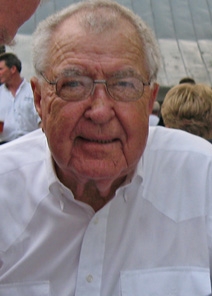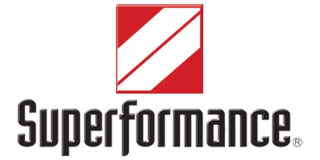Related Research Articles

The AC Cobra, sold in the United States as the Shelby Cobra and AC Shelby Cobra, is a sports car manufactured by British company AC Cars, with a Ford V8 engine. It was produced intermittently in both the United Kingdom and later the United States since 1962.

Carroll Hall Shelby was an American automotive designer, racing driver and entrepreneur. Shelby is best known for his involvement with the AC Cobra and Mustang for Ford Motor Company, which he modified during the late 1960s and early 2000s. He established Shelby American in 1962 to manufacture and market performance vehicles. His autobiography, The Carroll Shelby Story, was published in 1967.

Daniel Sexton Gurney was an American racing driver, race car constructor, and team owner who reached racing's highest levels starting in 1958. Gurney won races in the Formula One, Indy Car, NASCAR, Can-Am, and Trans-Am Series. Gurney is the first of three drivers to have won races in sports cars (1958), Formula One (1962), NASCAR (1963), and Indy cars (1967), the other two being Mario Andretti and Juan Pablo Montoya.

The Shelby Daytona Coupe is an American sports-coupé. It is related to the Shelby Cobra roadster, loosely based on its chassis and drive-train developed and built as an advanced evolution. It was engineered and purpose built for auto racing, specifically to take on Ferrari and its 250 GTO in the GT class. The original project had six Shelby Daytona Coupes built for racing purposes between 1964 and 1965, as Carroll Shelby was reassigned to the Ford GT40 project to compete at the 24 Hours of Le Mans, again to beat Ferrari in the highest level prototype class. With the Shelby Daytona, Shelby became the first American constructor to win a title on the international scene in the FIA International Championship for GT Manufacturers in 1965. In 2014, the first Cobra Daytona Coupe became the first vehicle recorded under a U.S. federal program for documenting historically important national treasures.

Robert Lewis Bondurant was an American racecar driver who raced for the Shelby American, Ferrari, and Eagle teams. Bondurant was one of the most famous drivers to emerge from the Southern California road racing scene in the 1950s, and achieved success in North America and in Europe. His Bob Bondurant School of High Performance Driving has been responsible for training generations of American racing drivers.

Specialty Equipment Market Association (SEMA) of the automobile aftermarket was formed in 1963 by Paul Schiefer, Roy Richter, Ed Iskenderian, Els Lohn, Willie Garner, Bob Hedman, Robert E. Wyman, John Bartlett, Phil Weiand Jr, Al Segal, Dean Moon, and Vic Edelbrock Jr. and now consists of 6,383 companies worldwide, bringing together aftermarket manufacturers, original equipment manufacturers (OEM), media, car dealers, specialty equipment distributors, installers, retailers, and restoration specialists.

David George MacDonald was an American racing driver noted for his successes driving Corvettes and Shelby Cobras in the early 1960s. He was killed in the 1964 Indianapolis 500, along with fellow driver Eddie Sachs.

Kenneth Henry Jarvis Miles was an English sports car racing engineer and driver best known for his motorsport career in the U.S. and with American teams on the international scene. He is an inductee to the Motorsports Hall of Fame of America. As an automotive engineer, he is known for developing the Ford GT40 along with driver and designer Carroll Shelby, which won at Le Mans in 1966, 1967, 1968 and 1969. His and Shelby's efforts at Le Mans were dramatized in the 2019 Oscar-winning film Ford v Ferrari.

Shelby American, Inc. is an American high performance automobile company founded by driver Carroll Shelby. The Shelby American name has been used by several legally distinct corporations founded by Shelby since his original shop in Venice, California began operation in 1962. The current iteration is a wholly owned subsidiary of Carroll Shelby International, Inc., a holding company formed in 2003. Carroll Shelby International's other wholly owned subsidiary is Carroll Shelby Licensing, which licenses the name and trademarks associated with Shelby to other companies. Shelby American was the first automobile manufacturer in the state of Nevada. Shelby American manufactures component automobiles, including replicas of the small-block and large-block AC Cobras, the Shelby GT350 and the GT500 Super Snake. Since 2005, Shelby American has released new models each year.
Daytona Coupe may refer to:

Superformance LLC is an American automobile company that builds, designs, develops, engineers and markets sports cars, related performance components and full replicars. The company was founded as "Superformance International Inc." by Hi-Tech Automotive Ltd. in 1996. Today, Superformance has 15 authorized dealers in the United States and 6 international dealers. SPF cars are sold as "turnkey-minus replacers". In December, 2005 Hi-Tech Automotive transferred the ownership of its subsidiary, Superformance, to American Hillbank Automotive Group, which is a privately owned business of American entrepreneur Lance Stander. Hi-Tech Automotive continue to build Superformance cars at its plant in Port Elizabeth, South Africa.
American Racing Equipment Inc. is a manufacturer of wheels sold via the aftermarket retail sector. Production started during the muscle car era in the United States. Platinum Equity investment group acquired American Racing Equipment Inc. in June 2005.
John Morton is an American racing driver from Waukegan, Illinois.
The Sportscar Vintage Racing Association (SVRA) is an American automobile club and sanctioning body that supports vintage racing in the United States. The organization was founded in 1981, and is regarded as the premier vintage racing organization in the U.S.

William Weyman Stephens Jr., known professionally as Bill Stephens is an American network television host, commentator, and narrator specializing in automotive and motorsports presentations. He is a nationally published author of several motorsports books and a columnist for a number of automotive periodicals. He is a television producer and writer for various automotive television programs, a professional vehicle appraiser, and a communications consultant providing media training for motorsports personalities and vocal and listening skills training for business people at all levels of the corporate world.
Horst Kwech was an Australian race car driver, race car constructor, engineer and inventor known primarily for his several wins in the early Trans-Am Series races of the 1960s and the beginning of the 1970s.
This article documents the events that occurred in motorsports in the 1960s.
The Simeone Foundation Automotive Museum is an automotive museum located at 6825 Norwitch Drive in Philadelphia, Pennsylvania. The museum's collection consists of approximately 75 racing sports cars and has been assembled over more than 50 years by Frederick A. Simeone, a retired neurosurgeon and native of Philadelphia. Frederick Simeone has been ranked the #1 car collector by the Classic Car Trust Registry.

George Damon Levy is a motorsports author, speaker, and historian and former editor of the enthusiast magazine Autoweek, and current President of the Motorsports Hall of Fame of America. He has contributed to various automotive publications and websites, including Autoweek, RACER, Car and Driver and Vintage Motorsport. He is best known for his 2016 book Can-am 50th Anniversary: Flat Out with North America’s Greatest Race Series, which earned a Gold Medal in the 2017 International Automotive Media Competition. He is a frequent collaborator with his longtime friend, the late, award-winning motorsports photographer Pete Biro. Their second book, F1 Mavericks: The Men and Machines that Revolutionized Formula 1 Racing, was published in July, 2019. More books together are in development.
References
- ↑ 1963 Chevrolet Corvette Press Kit.
- 1 2 3 Raynal, Wes (December 23, 2013). "An Insider's Sting Ray Story". Autoweek: 15.
- 1 2 Cushing, Jeff (June 28, 1972). "Brock's Datsuns Tough to Beat". Virgin Islands Daily News. Retrieved 23 July 2016.
- ↑ "Brock Racing Enterprises relocates to Henderson, NV".
- ↑ "Peter Brock" (PDF). International Society for Vehicle Preservation. Retrieved 26 August 2012.
- ↑ "Art Center College of Design Peter Brock Lifetime Achievement Award".
- ↑ "Peter Brock Honored with RRDC's 2013 Phil Hill Award". January 2013.
- ↑ Simeone, Museum (November 2016). "2016 Spirit of Competition Award honoring Peter Brock".
- ↑ "Honorees Chosen as 2017 SCCA Hall of Fame Inductees". Sports Car Club of America. 5 Dec 2016. Retrieved 7 February 2022.
- ↑ Motorsports Hall of Fame. "Peter Brock Inducted into Motorsports Hall of Fame Class of 2022".
- ↑ Murphy, Tom (September 2022). "The American Speed Festival is honoring Brock for designing the Shelby Daytona Cobra, helping shape the C2 Corvette, and for his long love affair with racing".
- 1 2 Lerner, Preston (June 2020). "The Prodigy".
{{cite web}}: Check|archive-url=value (help)